The University of Macau (UM) has developed a new and ambitious research strategy. UM has also been building and improving a new ‘5-in-1’ system for research innovation and results transfer. The new system, which aims to support the economic diversification of Macao, includes high-level platforms for various stages of industry-academia collaboration, including innovation, service, management, cultivation, and implementation. It will enable the university to enhance the quality and impact of its research results, to further promote research and innovation, and to support the systematic transfer of research results.
Strategic Research Layout
According to Prof Ge Wei, UM vice rector for research, the Macao Special Administrative Region (SAR) government attaches great importance to industry-academia collaboration and many people in the community expect further progress in this realm. As a response, UM has identified several areas to give priority to research, innovation, and the transfer of research results.
Research and innovation are among the most important aspects of industry-academia collaboration. To this end, UM has developed a ‘3+3+3+3’ strategic research layout. The first ‘3’ refers to the three state key laboratories for Chinese medical sciences, microelectronics, and the internet of things for smart cities, respectively. The second ‘3’ refers to three emerging research areas, namely precision medicine (mainly through the Faculty of Health Sciences), advanced materials (mainly through the Institute of Applied Physics and Materials Engineering), and regional oceanology (mainly through the Centre for Regional Oceans).
The third ‘3’ refers to the three interdisciplinary research areas supported by three centres under the Institute of Collaborative Innovation (ICI), namely the Centre for Cognitive and Brain Sciences, the Centre for Data Science, and the Centre for Artificial Intelligence and Robotics. The three centres all span the fields of humanities and social sciences as well as science and technology, and are all equipped with advanced facilities and equipment, with many of the users being professors of humanities and social sciences.
The fourth ‘3’ refers to the three university-level research platforms of UM in the humanities and social sciences, areas where the university has a strong research culture. They include the recently-established Institute for Advanced Studies in Humanities and Social Sciences, the Asia-Pacific Academy of Economics and Management, and the Centre for Macau Studies. All of the elements above combine to form a mechanism for research and innovation at UM, which is also the first and most important type of platform in the ‘5-in-1’ system.
A Transfer System that Creates Synergy
The ‘5-in-1’ system for research innovation and results transfer is an important part of the university’s Five-Year Development Plan (Academic Year 2021/2022-2025/2026). This system aims to build and enhance platforms for the five phases of industry-academia collaboration, namely innovation, service, management, cultivation, and implementation. ‘While each of the five categories of platforms has an individual role to play, the system allows them to interact with each other,’ says Prof Ge. ‘When different platforms are integrated into one, synergies can be created.’
Service platforms constitute the second type of platform in the ‘5-in-1’ system. Most are operated by the Research Services and Knowledge Transfer Office. The office provides research services to staff and students, and handles the management and transfer of intellectual property rights (IPRs) of UM, as well as their applications. According to Prof Ge, the available IPRs, patents, and research results call for management platforms, which are the third type of platform in the ‘5-in-1’ system. UMTec Limited, a wholly-owned subsidiary of UM, is primarily responsible for managing these IPRs. The university entrusts UMTec Limited to manage, promote and apply all its IPRs, including more than 100 patents filed in mainland China and overseas, and their commercialisation. ‘If a company wants to use a technology from UM, it can turn to UMTec rather than the university,’ says Prof Ge. ‘UMTec plays a central role in our industry-academia collaboration system. The company takes care of the final phase of transferring our IPRs.’
Cultivation Platform for Innovation and Entrepreneurship
Most professors and students lack commercial experience. That is why UM has included cultivation platforms in the ‘5-in-1’ system as the fourth type of platform. The Centre for Innovation and Entrepreneurship (CIE) under the ICI provides various types of support, training, and services to students and professors who want to start a business. In 2019, which marked the 20th anniversary of the handover of Macao, the CIE received approval from the Ministry of Science and Technology to join China’s national system of co-working spaces.
Around 30 business teams, founded by UM students and faculty members, have been incubated in the CIE. When incubation is completed, the teams continue to exist as registered companies to contribute to the industrial diversification of Macao. ‘With shares in many start-up companies incubated at UM, UMTec is playing an important role in the transfer of the university’s IPRs,’ says Prof Ge.
Implementation Platform for Industry-Academia Collaboration
The fifth and last type of platform under the ‘5-in-1’ system is the implementation platform. Many teams incubated at the CIE have been connected by UMTec to companies for cooperation. Meanwhile, teams with products or technologies that are more mature and closer to market needs can approach potential partners directly.
Many products developed by UM research teams are still in their initial stages, but they show great promise for applications. In this context, the university would recommend they seek further development at the Zhuhai UM Science & Technology Research Institute (ZUMRI). As the university’s demonstration base for industry-academia collaboration in Hengqin, the institute has access to rich research resources in mainland China. In essence, ZUMRI is serving as UM’s implementation platform for industry-academia collaboration.As of today, the institute has about 160 ongoing or completed projects. They include over 110 projects funded by national, provincial, and municipal agencies and over 50 collaborative projects with enterprises.
‘The innovation, service, management, cultivation, and implementation platforms together form a fairly complete ecosystem for industry-academia collaboration. Sometimes researchers wonder what the next step will be for their research projects. With this system in place, we can show them exactly what the next step is.’ says Prof Ge.
Partnerships with Over 50 Companies
UM has transferred its research results in several key areas, including materials, biomedical sciences (including traditional Chinese medicine), the Internet of Things for smart city development, artificial intelligence, big data, and humanities (such as translation systems). UM actively collaborates with over 50 commercial partners, which are based in the mainland and Macao. The university’s local partners include Macao’s electricity company CEM, telecommunications provider CTM, and Nam Kwong (Group) Company Limited. In addition, UM signed a strategic collaboration framework agreement with Boardware Information System Limited in 2021 on the establishment of a joint laboratory. The university is also actively planning a joint laboratory with Akrostar Technology, a Macao-based chip unicorn company. ‘UM has extensive collaborations with public and private enterprises across Macao. One can easily see the university’s role in promoting technological and industrial innovation in this city.’
Right People, Right Time, and Right Place
UM has a vital role to play in helping the government promote technological innovation and transfer research results. According to Prof Ge, UM has encountered the right people in the right place at the right time, which will help the university fulfil its responsibility as a comprehensive public university. ‘The timing is right as UM is able to grasp the unprecedented opportunities brought about by the Guangdong-Hong Kong-Macao Greater Bay Area (GBA) for collaborative development. The Guangdong-Macao In-Depth Cooperation Zone in Hengqin established in 2021 has also given the university new impetus. We are in the right place because Macao is a core city of the GBA, and our university is located on Hengqin island,’ says Prof Ge. ‘The Macao SAR government attaches great importance to industry-academia collaboration. It has become clear to people from all sectors that economic diversification is essential for Macao’s future development. Industry-academia collaboration has therefore become a shared goal for all members of the community,’ says Prof Ge.
41 years after its founding, UM has become a university with many outstanding results. Now is the time that the university should accelerate industry-academia collaboration and take stock of past achievements to advance development. ‘Some of our university’s products in traditional Chinese medicine are about to be launched,’ says Prof Ge. ‘Many companies in the fields such as materials, traditional Chinese medicine, and microelectronics have already integrated technologies from UM into their products.’
In the process of research results transfer, the government and enterprises need to be fully involved, apart from initiatives from universities. Prof Ge says: ‘Companies give us a lot of ideas for research, and their input can help students and professors produce products or technologies that are closer to the needs of the market.’
Taking Advantage of GBA Opportunities to Transfer Research Results
The new system for research innovation and results transfer will bring UM researchers and units in all areas to work together. In the long run, the collaborative effort will improve the university’s research and innovation capacity and make industry-academia collaboration more effective. ‘The university will make better use of research resources provided by the central government as well as different provinces and cities. We will also launch more projects in research innovation and industry-academia collaboration with top universities and enterprises at home and abroad,’ says Prof Ge.
At the moment, the GBA is transforming itself into an international centre for innovation and technology, which will open up more opportunities for universities and researchers to transfer their research results. Against this backdrop, the new system for research innovation and result transfer at UM demonstrates not only the university’s vision and concrete actions to promote technology transfer, but also its determination to change society for the better through research.
Source: UMagazine Issue 25
Related articles:
1. UM Collaborates with Enterprises to Promote Research Results Transfer
2. Placing Products of High Technology on the Market
3. Promoting the Transfer of Innovative Medical Research Results in Macao
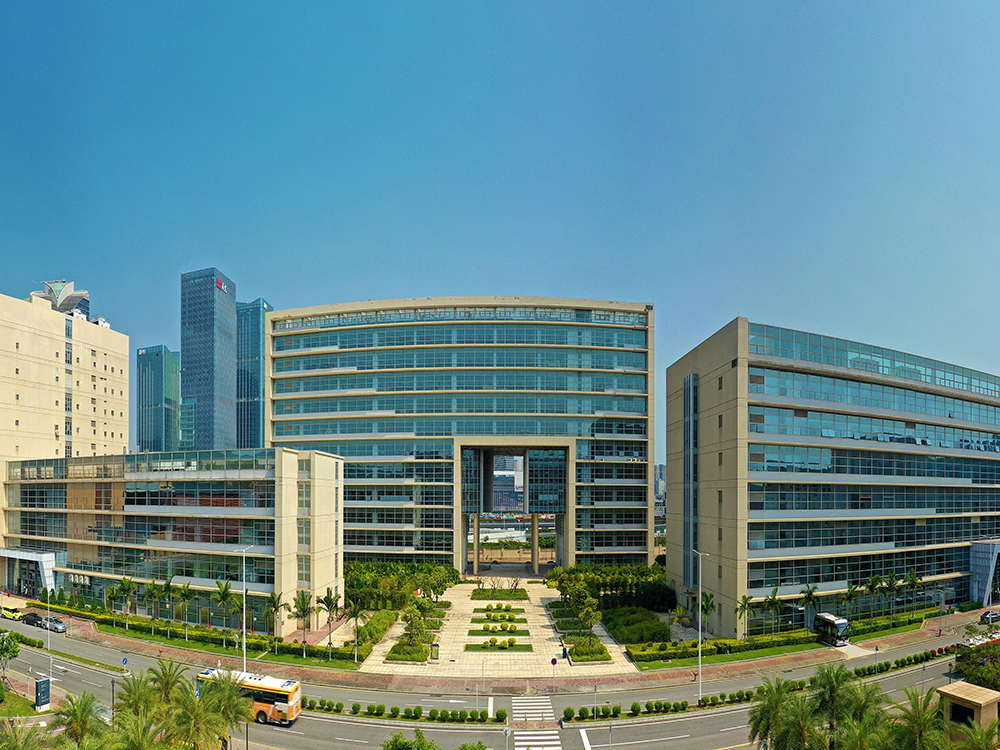
UM takes various steps to support industry-academia collaboration. This picture shows the scientific research base at UM.
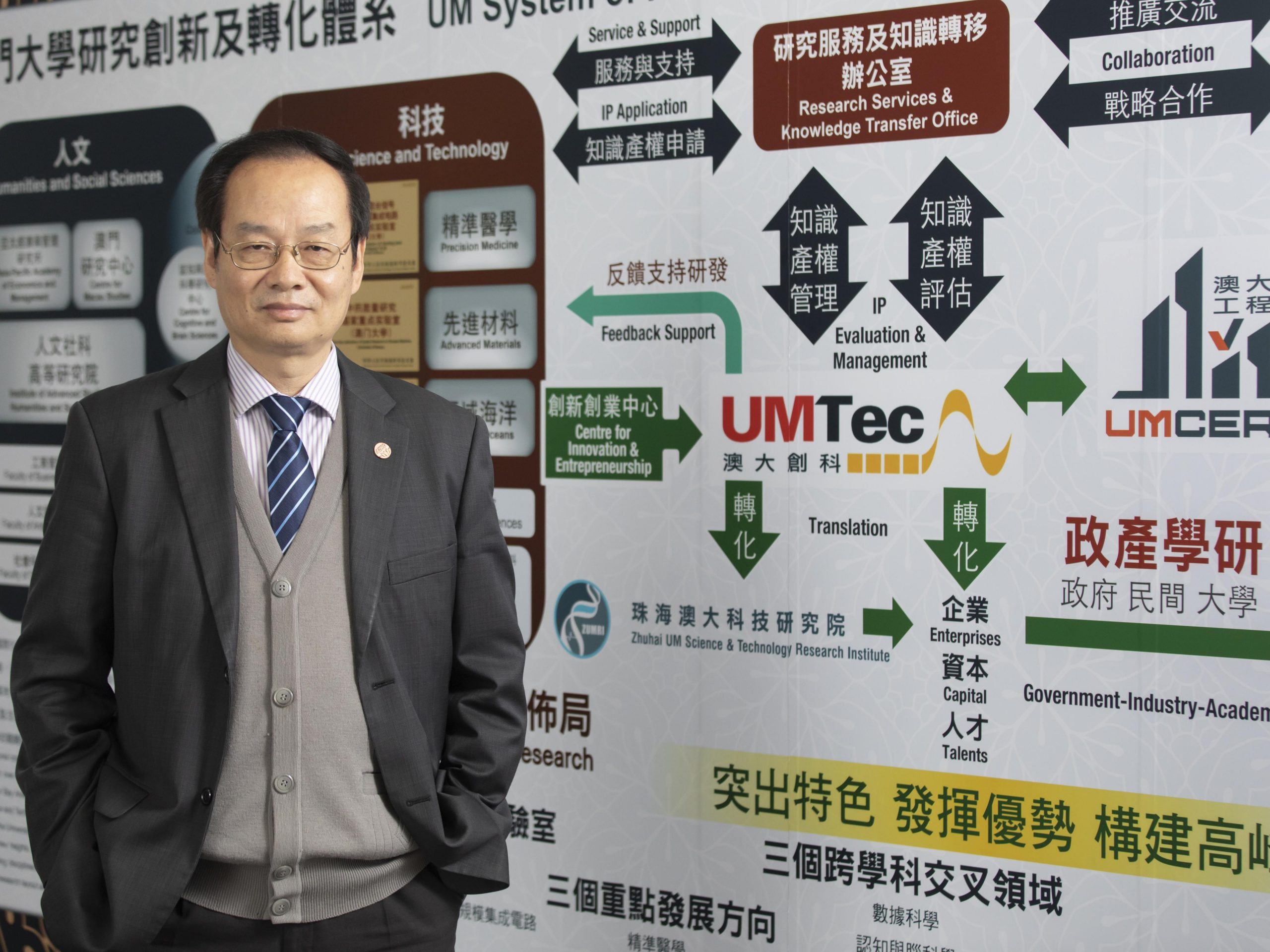
UM Vice Rector (Research) Ge Wei
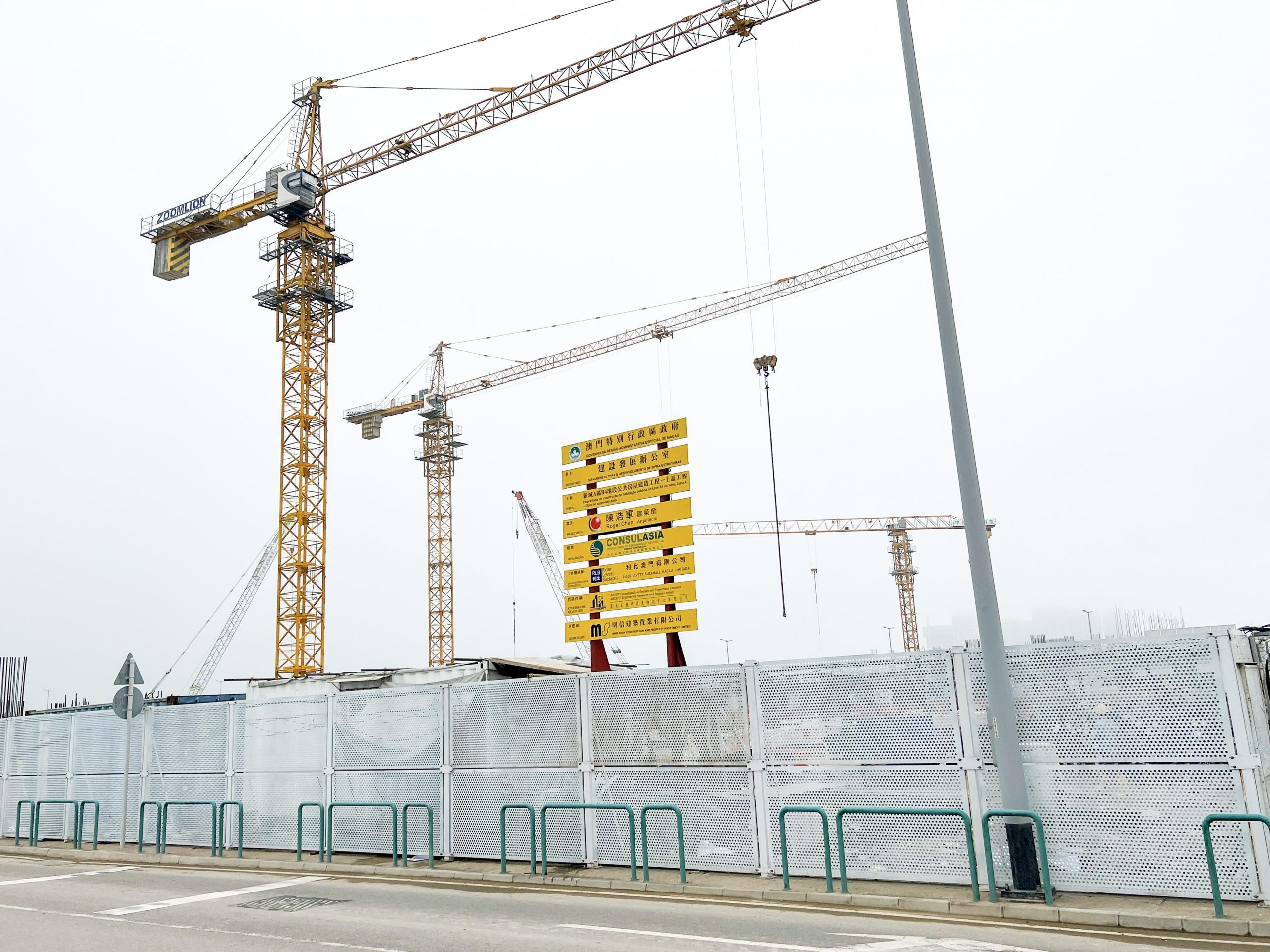
UMCERT Engineering Research and Testing Limited provide professional services for society
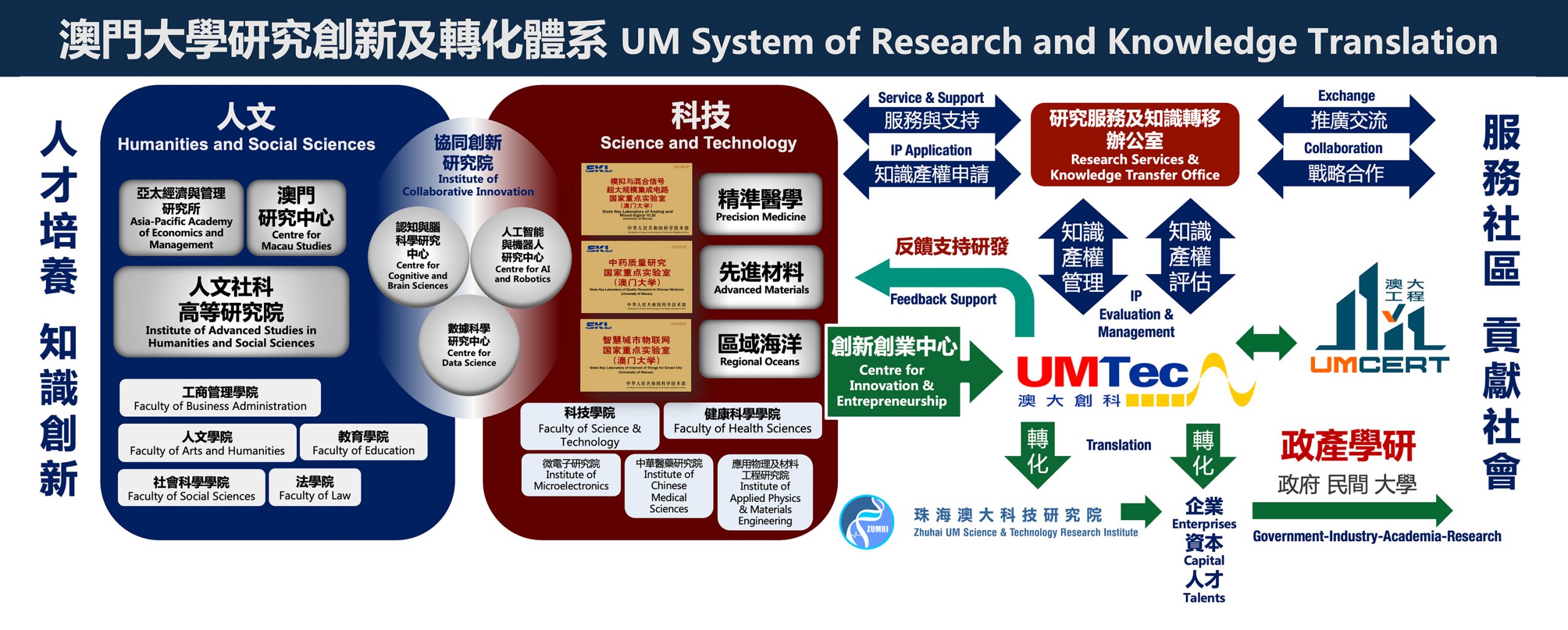
The system for research innovation and results transfer at UM
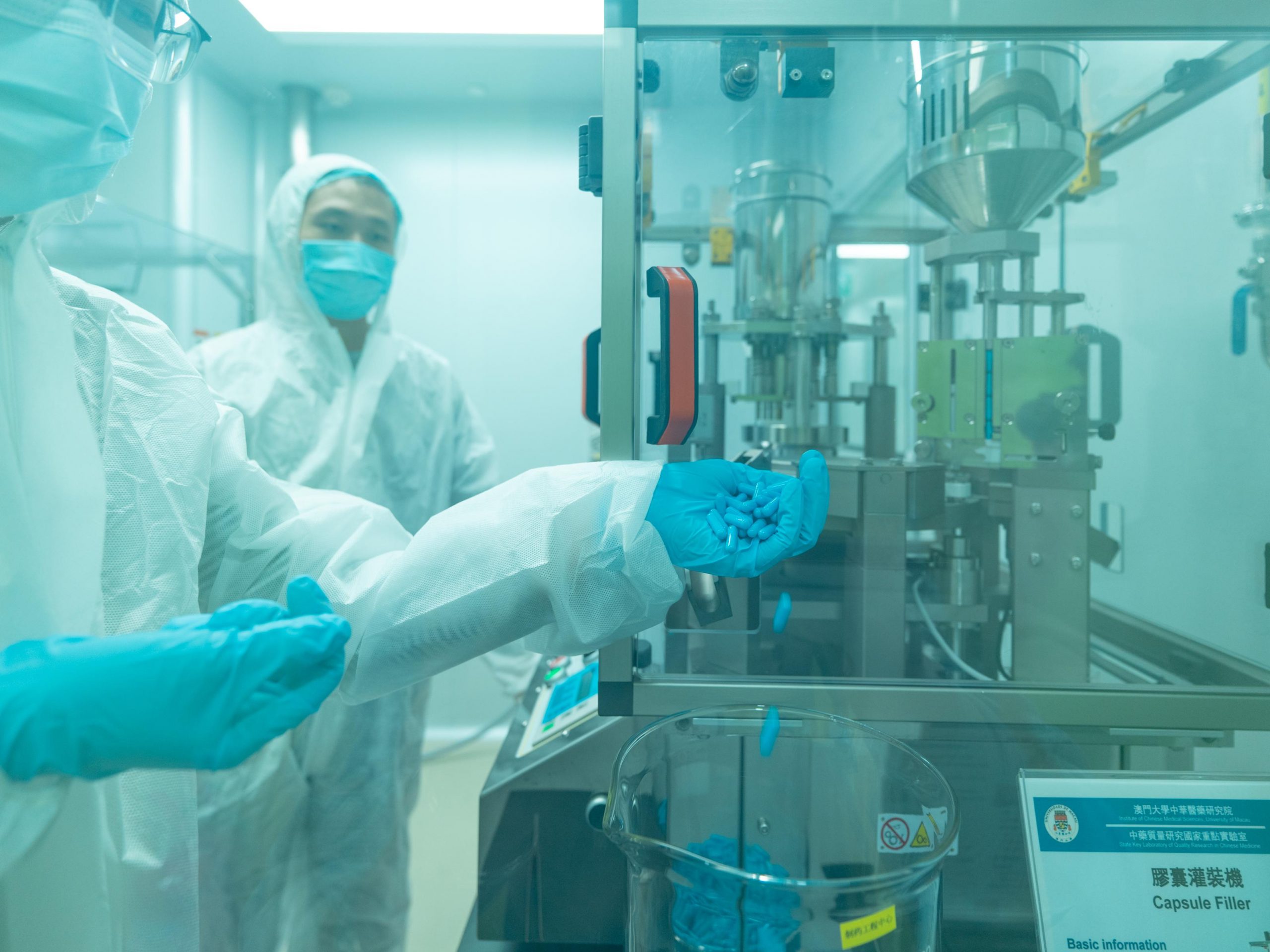
UM will soon launch some traditional Chinese medicine-based products
